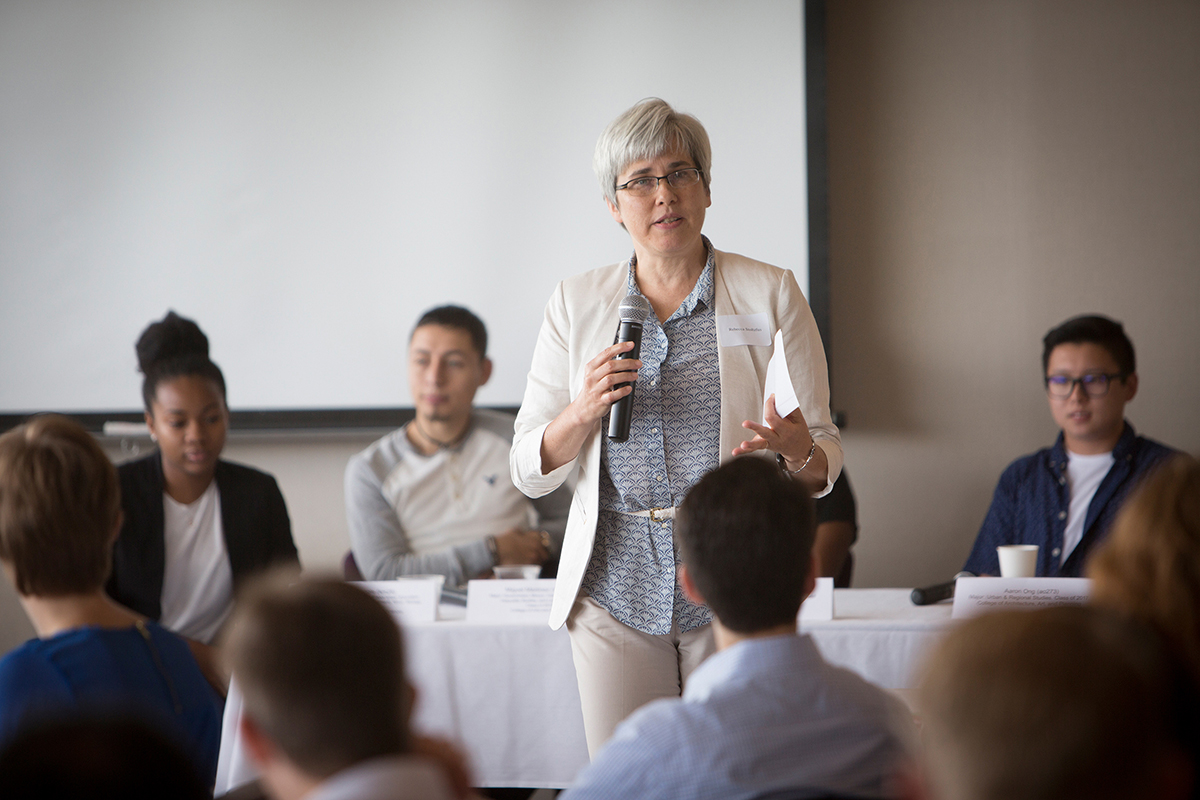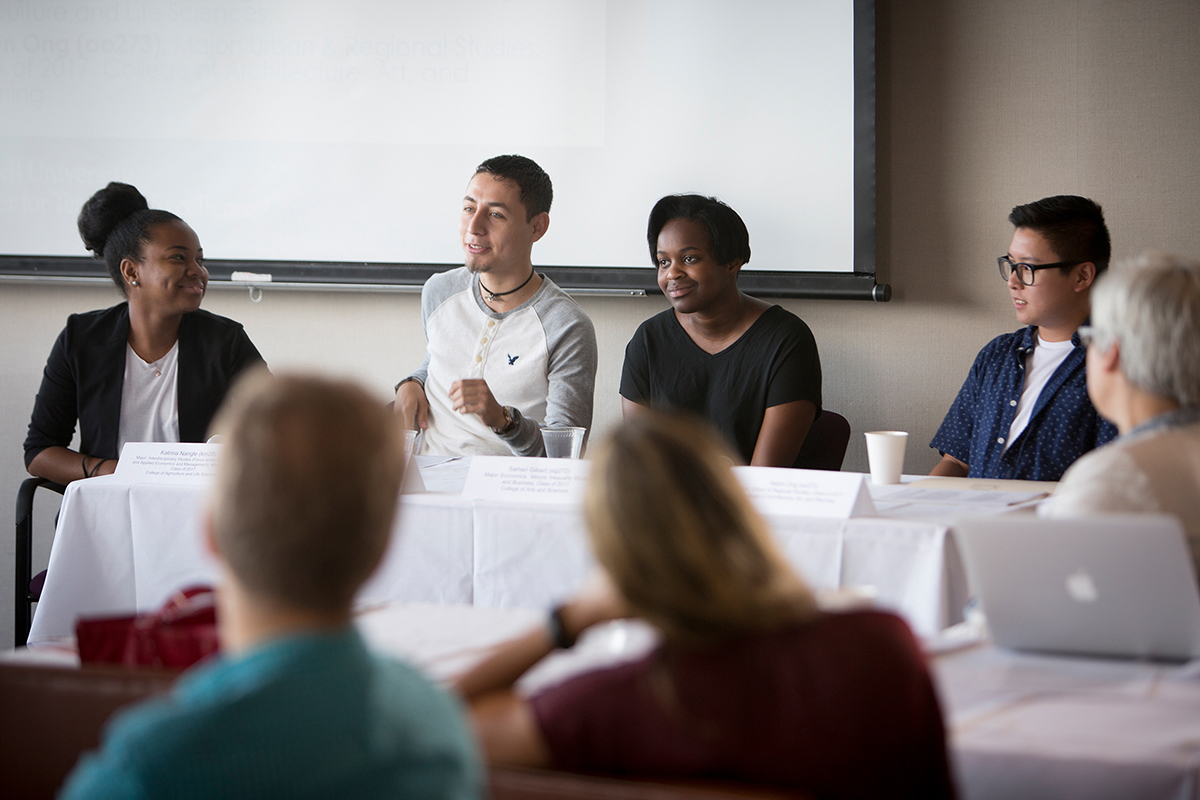Students discuss inclusive pedagogy for new faculty
By Daniel Aloi


Best practices for teaching while recognizing students’ diverse experiences and identities was the focus of a discussion on inclusive pedagogy during New Faculty Orientation Aug. 18 at the Herbert F. Johnson Museum of Art.
“Cornell is an extraordinarily diverse institution, and we view that as a tremendous opportunity for learning and a resource for learning and teaching,” said Becky Stoltzfus, vice provost for undergraduate education.
Diversity at Cornell has many dimensions, she said, including socio-economic status, gender identity and “cognitive diversity,” the different ways of thinking across academic disciplines.
While “all this makes Cornell a tremendously rich place to be,” she said, “at this time in our history, there is a lot of tension and cultural anxiety about diversity and diverse identities, and how we navigate those.”
Prepared questions framed the discussion for a panel of students, who described their expectations coming into Cornell classrooms and their learning experiences thus far, and how the university and its faculty have supported their cultural or social identity.
Discussing violence, extreme expression
Guidelines and suggestions are available for instructors and others to facilitate classroom, group or workshop discussions of recent public incidents of violence and extreme expression, and to prepare for such discussions.
The guidelines, assembled by A.T. Miller, associate vice provost for academic diversity, address the varied responses generated by international acts of terror, violence against unarmed civilians of color by law enforcement in the United States, and the targeted killing of police officers and LGBTQ individuals.
Miller conveyed that these incidents, as well as the rhetoric surrounding them, are contributing to a general sense of insecurity, vulnerability and anxiety for many people amid a current climate of heightened activism and contentious political speech and commentary. Discussions should be designed within boundaries that reach closure in the classroom or other setting, include all students or participants present, extend discourse beyond polarized and polarizing debates, and use tools for conceptual understanding and dialogue.
Further resources for navigating difficult discussions are available to the Cornell community, including the Center for Teaching Excellence and Intergroup Dialogue Project, or contacting university diversity officers.
“I expected to be challenged, to be pushed to my limits and sometimes beyond,” said Katrina Nangle ’17, an interdisciplinary studies major. “Coming from New York City, I was expecting a slower pace; and in terms of the classroom I was not expecting having 300 people in a class – it was culture shock.”
Nangle highlighted the need for diverse identities in a course syllabus, with scholars of varying backgrounds represented, when possible; and noting their absence when they’re not.
“There’s only a handful of classes where I’ve related to the curriculum,” she said. “Women’s contributions have become easy to overlook.”
Government major Miguel Martinez ’18, a first-generation student from San Antonio, Texas, said: “Nobody is unbiased; it’s impossible. We all have different backgrounds and viewpoints.”
The panelists also sought acknowledgement of their lives outside of the classroom.
“A class is such a small part of the college experience,” economics major Samari Gilbert ’17 said. One professor noticed that Gilbert had been in the news in her role as president of Black Students United on campus, she said, and he initiated a one-on-one conversation about Black Lives Matter and issues facing her and other students of color.
Asked what they would want a professor to know about them that would help their learning, the panelists offered advice.
“I tend to approach faculty that seem approachable, and if they get to know me and know my name I’m much more likely to tell them if I’m having a difficult time,” Nangle said.
“Be genuine with your intentions, and get to know your students because they provide a lot of perspectives that you may not be familiar with,” Martinez said. “Don’t penalize students if they don’t participate in the class … some students are more shy than others, so consider other options for participation.”
Aaron Ong ’17, an urban and regional studies major from Singapore, said: “When I came to the United States [and Cornell] I was very surprised that in the classroom there is so much emphasis on participation – here you are adjusting to a new culture, a new environment, and you feel this incredible pressure to participate. I know a lot of foreign students who struggle with it.”
The faculty orientation was organized by the Provost’s Office of Faculty Development and Diversity and the student panel was facilitated by Kimberly Kenyon, associate director of the Center for Teaching Excellence (CTE).
Stoltzfus cited several resources available to faculty – including CTE, the Faculty Institute for Diversity and the Office of Academic Diversity Initiatives – to assist them in ways to “make Cornell a welcoming, inclusive, engaging, educational, informative space for all of us.”
“The bottom line for me is to be open and to be responsive to the diversity that we encounter; having your eyes and hearts really open to what’s happening in your classroom and being responsive to that,” she said.
Media Contact
Get Cornell news delivered right to your inbox.
Subscribe